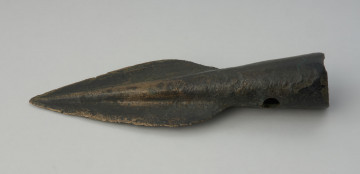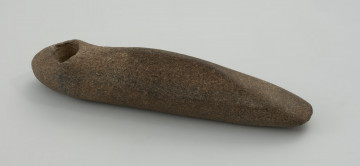
A javelin or spearhead
around 1600 p.n.e. — 1500 p.n.e.
National Museum in Szczecin
Part of the collection: Bronze Age
The bronze axe, discovered in 1914 during the deepening of the Oder waterway at the level of Gryfino town, is distinguished by its slender form, emphasized by a narrow blade with a fan-shaped point. It belongs to the so-called “Oleszna type” and is a rare find in Poland. The axe was most probably a sacrificial deposit offered to deities, which is indicated by the circumstances of its discovery. Water environments, especially rivers, played a significant role in the culture of Bronze Age communities. Weapons are often discovered in such locations, while other bronze objects - vessels, tools and ornaments, are found mainly in swamps and lakes. The presented axe comes from the Late Bronze Age (ca. 1600-1300 BC). It is associated with the local population representing the so-called Ukrani and West Pomeranian group, culturally close to the communities of neighbouring Mecklenburg. Analysis of the objects discovered in such hoards shows that the people of this group had access to luxurious imported products. Their presence in the area confirms that they maintained the trade contacts initiated earlier with communities living in the middle Danube basin.
Monika Witek
Author / creator
Dimensions
the entire object: height: 15.5 cm, width: 5.67 cm
Object type
tool, weapon
Technique
cast
Material
bronze
Origin / acquisition method
legal transfer
Creation time / dating
Creation / finding place
Owner
National Museum in Szczecin
Identification number
Location / status

around 1600 p.n.e. — 1500 p.n.e.
National Museum in Szczecin

National Museum in Szczecin

1970
National Museum in Szczecin
DISCOVER this TOPIC
National Museum in Szczecin
DISCOVER this PATH
Educational path